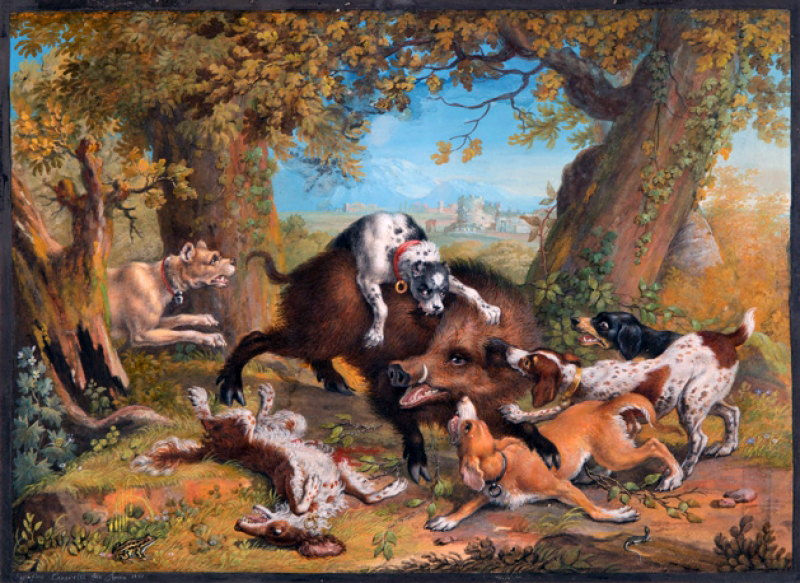Temple of Castor and Pollux by Franz Kaisermann
Watercolor on outline etching representing an animated view of the Roman Forum with in the foreground the tree columns of the Temple of Castor and Pollux with behind the Capitoline Hill.
Author Kaisermann Franz (1765-1833)
Dimension: cm 30x40, cm 60x70 with frame
Condition excellent commensurate with age.
The Temple of Castor and Pollux (Italian: Tempio dei Dioscuri) is an ancient temple in the Roman Forum, Rome. It was originally built in gratitude for victory at the Battle of Lake Regillus (495 BC). Castor and Pollux (Greek Polydeuces) were the Dioscuri, the "twins" of Gemini, the twin sons of Zeus (Jupiter) and Leda. Their cult came to Rome from Greece via Magna Graecia and the Greek culture of Southern Italy. The last king of Rome, Lucius Tarquinius Superbus, and his allies, the Latins, waged war on the infant Roman Republic. Before the battle, the Roman dictator Aulus Postumius Albus Regillensis vowed to build a temple to the Dioscuri if the Republic were victorious. According to legend Castor and Pollux appeared on the battlefield as two able horsemen in aid of the Republic; and after the battle had been won they again appeared on the Forum in Rome watering their horses at the Spring of Juturna thereby announcing the victory. The temple stands on the supposed spot of their appearance. One of Postumius’ sons was elected duumvir in order to dedicate the temple on 15 July (the ides of July) 484 BC.
Watercolor on outline etching representing an animated view of the Roman Forum with in the foreground the tree columns of the Temple of Castor and Pollux with behind the Capitoline Hill.
Author Kaisermann Franz (1765-1833)
Dimension: cm 30x40, cm 60x70 with frame
Condition excellent commensurate with age.
The Temple of Castor and Pollux (Italian: Tempio dei Dioscuri) is an ancient temple in the Roman Forum, Rome. It was originally built in gratitude for victory at the Battle of Lake Regillus (495 BC). Castor and Pollux (Greek Polydeuces) were the Dioscuri, the "twins" of Gemini, the twin sons of Zeus (Jupiter) and Leda. Their cult came to Rome from Greece via Magna Graecia and the Greek culture of Southern Italy. The last king of Rome, Lucius Tarquinius Superbus, and his allies, the Latins, waged war on the infant Roman Republic. Before the battle, the Roman dictator Aulus Postumius Albus Regillensis vowed to build a temple to the Dioscuri if the Republic were victorious. According to legend Castor and Pollux appeared on the battlefield as two able horsemen in aid of the Republic; and after the battle had been won they again appeared on the Forum in Rome watering their horses at the Spring of Juturna thereby announcing the victory. The temple stands on the supposed spot of their appearance. One of Postumius’ sons was elected duumvir in order to dedicate the temple on 15 July (the ides of July) 484 BC.
Watercolor on outline etching representing an animated view of the Roman Forum with in the foreground the tree columns of the Temple of Castor and Pollux with behind the Capitoline Hill.
Author Kaisermann Franz (1765-1833)
Dimension: cm 30x40, cm 60x70 with frame
Condition excellent commensurate with age.
The Temple of Castor and Pollux (Italian: Tempio dei Dioscuri) is an ancient temple in the Roman Forum, Rome. It was originally built in gratitude for victory at the Battle of Lake Regillus (495 BC). Castor and Pollux (Greek Polydeuces) were the Dioscuri, the "twins" of Gemini, the twin sons of Zeus (Jupiter) and Leda. Their cult came to Rome from Greece via Magna Graecia and the Greek culture of Southern Italy. The last king of Rome, Lucius Tarquinius Superbus, and his allies, the Latins, waged war on the infant Roman Republic. Before the battle, the Roman dictator Aulus Postumius Albus Regillensis vowed to build a temple to the Dioscuri if the Republic were victorious. According to legend Castor and Pollux appeared on the battlefield as two able horsemen in aid of the Republic; and after the battle had been won they again appeared on the Forum in Rome watering their horses at the Spring of Juturna thereby announcing the victory. The temple stands on the supposed spot of their appearance. One of Postumius’ sons was elected duumvir in order to dedicate the temple on 15 July (the ides of July) 484 BC.






